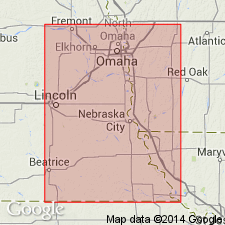
- Usage in publication:
-
- Holt shale bed
- Modifications:
-
- Original reference
- Dominant lithology:
-
- Shale
- AAPG geologic province:
-
- Forest City basin
Summary:
Pg. 42, 52, 53. Holt shale bed of Topeka limestone member of Shawnee formation. A thin but persistent bed of shale in Topeka limestone member of Shawnee formation. Is bluish and argillaceous above and black and fissile in middle and lower parts. Thickness in Nebraska 1 to 2.5 feet; in Iowa 1 foot-10 inches; in Kansas 2.5 feet; at Forest City, Missouri, 2 feet-4 inches. Underlies Coal Creek limestone bed and overlies Du Bois limestone bed, all included in Topeka limestone. Age is Late Pennsylvanian (Missouri age). Report includes cross sections, measured sections, geologic maps, stratigraphic tables.
Named from good exposures in Holt Co., northwestern MO, just below Forest City and northwest of Oregon.
Source: US geologic names lexicon (USGS Bull. 896, p. 971); GNC KS-NE Pennsylvanian Corr. Chart, sheet 1, Oct. 1936; supplemental information from GNU records (USGS DDS-6; Denver GNULEX).
For more information, please contact Nancy Stamm, Geologic Names Committee Secretary.
Asterisk (*) indicates published by U.S. Geological Survey authors.
"No current usage" (†) implies that a name has been abandoned or has fallen into disuse. Former usage and, if known, replacement name given in parentheses ( ).
Slash (/) indicates name conflicts with nomenclatural guidelines (CSN, 1933; ACSN, 1961, 1970; NACSN, 1983, 2005, 2021). May be explained within brackets ([ ]).

